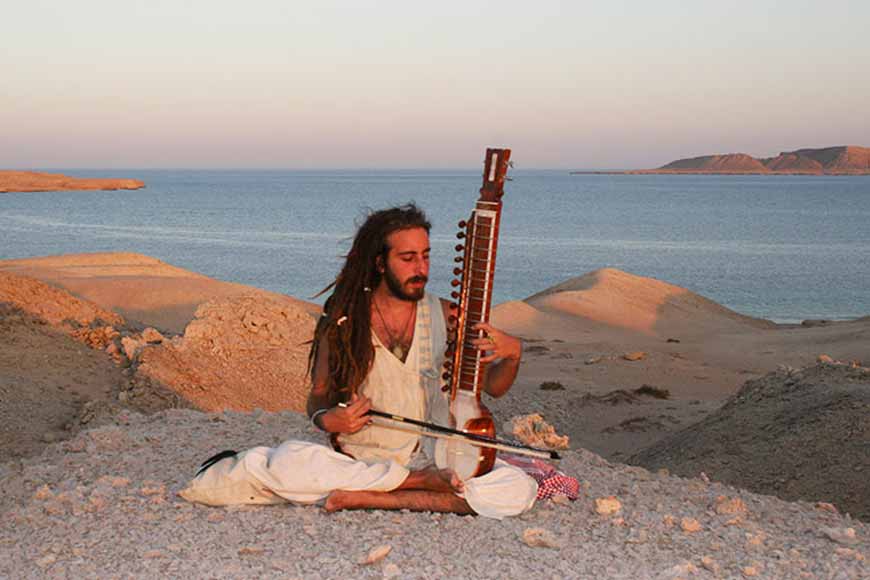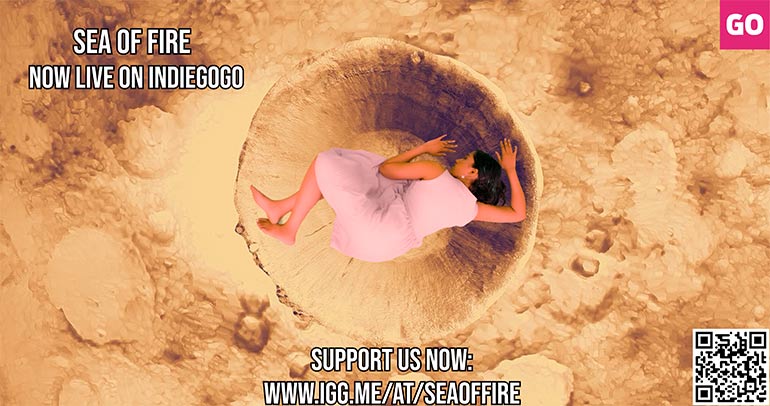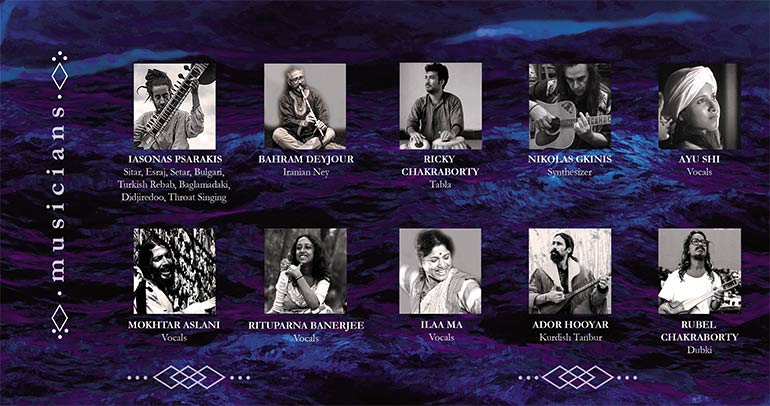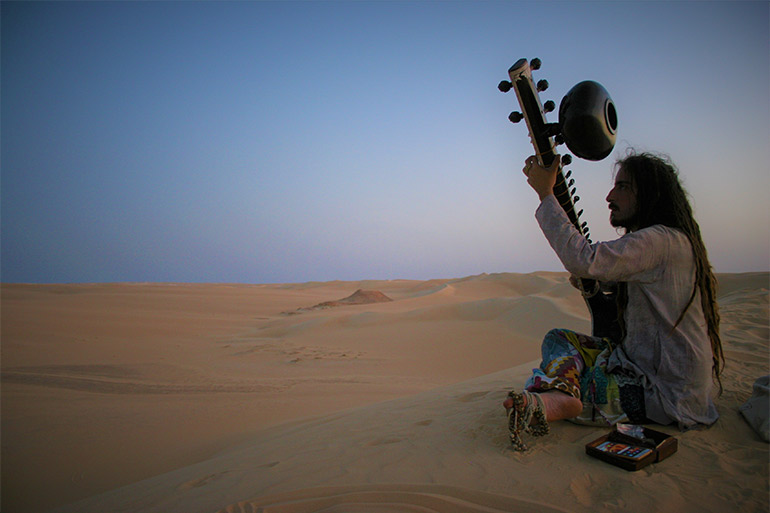Iasonas Psarakis: Weaving Greek Roots with Indian Ragas - GetBengal Story

Iasonas Psarakis is a Greek-born composer, musician, and filmmaker, specializing in North Indian classical music and global music traditions. He came to India from Greece and earned a degree in Hindustani classical music (sitar) from the Music Faculty at Visva-Bharati University. Iasonas’s music has reached audiences in Greece, India, Egypt, Italy, Lebanon, Bangladesh, Turkey, and Iran. His 2023 album Astris won multiple awards and even received votes in the first round of the Grammy Awards. After spending nearly four years in Santiniketan and Kolkata, he has returned to his native village to continue spreading the tradition of Indian classical music. Suman Sadhu, Executive Editor of Bangadarshan.com, spoke with him.

Suman: First of all, tell us about your village in Greece. What’s life like there?
Iasonas: My village is called Pefki, located on the island of Crete in southern Greece. After three years of traveling across the Middle East and four years studying Indian classical music in West Bengal—mainly sitar and esraj—lockdowns started, and I returned to Pefki. It’s a tiny mountain village of only 30 residents, from which you can also see the sea. There are no big roads, only small winding lanes. Surrounded by astonishingly beautiful nature, it’s an ideal place for music creation, practice, and other artistic work. You could say my village is the primary source of inspiration for my music.
Suman: At what age did music first attract you, and how did it begin?
Iasonas: Music fascinated me from as early as I can remember. I grew up in an artistic family, and our home was always open for musical gatherings. Even as a child, I would wander the outdoors in summer with my parents and their musician friends, singing and absorbing music from nature.
I began formal training at age ten. At a conservatory in Athens, I studied classical guitar and European classical music until I was seventeen. During this time, I also wrote songs inspired by social and environmental themes, performing them in my own way.
At eighteen, I left the capital to live alone. For about four years, I moved to the island of Lesvos and later to other remote Greek islands. There, I experimented with instruments like didgeridoo, xylophone, lute, and guitar. I was creating my own psychedelic, experimental music, though I didn’t keep recordings from that period.
Suman: Indian classical music is thousands of years old. How did studying and practicing it affect you, even though you’re not Indian?
Iasonas: Indian classical music entered my life unexpectedly, almost mysteriously. When I was sixteen, I first heard the sitar on a remote beach in southern Crete. Its sound, shape, and vibrations amazed me—they were completely different from anything I had experienced.
At eighteen, I began listening to Ravi Shankar’s albums. His reverence for the sitar and the instrument’s sound profoundly moved me. It felt almost divine. From the age of nineteen, I began dreaming about the sitar every night for months. It felt as if the instrument was calling me from another dimension.
I decided to dedicate my life to the sitar. I bought my first sitar and went to a remote island in southern Greece. For six months, it was just me and my sitar, weaving dreams together. Gradually, a special connection was formed, and I experienced a peculiar new form of energy.

Not long after, armed with my sitar and 10 euros, I set off on my own, to India, to learn.I traveled throughout Turkey, Iran and Lebanon—playing music at a variety of festivals, socializing with Sufi and Dervish circles, playing with Iranian musicians and even performing on Iranian instruments related to the sitar. I hadn’t yet made it to India, but the trip had a profound effect on me.
Two and a half years later, I went to a mystic music festival in Konya Turkey. There I met incredible masters from India, Iran and Pakistan. I spent time with Ustad Zakir Hussain and Ustad Ashish Khan. We talked about music for a duration of time, and I asked Ashish to give me a lead to a sitar teacher in India. He connected me with his sister, Amina Perera (daughter of Ustad Ali Akbar Khan).
Suman: Then you moved to Kolkata to study under Amina Perera. You also began learning esraj and studying at Visva-Bharati in Santiniketan. What were those early days like, and how did Rabindranath Tagore’s music influence you?
Iasonas: The first concert I performed as Amina Perera's student took place at the Kala Bhavana in Santiniketan. Having previously read tagged work translated in Greek while in Greece, it was indeed like a dream to be in Santiniketan.
In scope this is because when I arrived, I spent the first several days with a Baul family, and was entranced by the atmosphere of Visva-Bharati, the surrounding nature, and above all the philosophies of Rabindranath Tagore and Lalon Fakir. Santiniketan became for me a utopian type of place to study, practice and live.

With Amina Perera’s help, I received an ICCR scholarship to study sitar at the Music Faculty of Visva-Bharati for three years. I attended her classes twice a week in Kolkata, practicing sometimes six to ten hours in a day. After her death, I studied with Pandit Deviprasad Chatterjee and began lessons on esraj, the second of my instruments. I continue to practice both sitar and esraj every day.
Suman: You spent nearly a year in Kolkata. What is the greatest treasure you returned with from West Bengal that you would like to share with future generations?
Iasonas: I have received many gifts after spending four years in West Bengal, but the most valuable of these are the humanistic and spiritual gifts. From Tagore and Lalon, I have absorbed the philosophy of Indian classical music, its ties to one's roots, and the intricacies of artistic vision. I attended to the spiritual grounding of classical music...the way each raga connects to nature, the time, emotions, and imagery. I will hold these lessons for life, and I sincerely hope I can share them with the future.
Ultimately, I hope, in southern Crete, to create a center for world music/arts, for senior musicians from traditions such as India or Iran to train students and inspire them. It would be a space to present the culture of Indian classical music and the sound of the sitar to people everywhere.
Suman: You have given concerts across the world. After graduation, how did your musical path continue?
Iasonas: After I graduated, I traveled to Egypt and I performed my first solo concert in Cairo under the patronage of the Library of Alexandria. That experience was the beginning of my new life as an independent artist. I returned to Greece where I performed more concerts, letting my music and my songs travel far and wide. I had applied for another ICCR scholarship to pursue another postgraduate sitar degree in Santiniketan, however it was cancelled because of COVID-19.
When we were all on lockdown in 2020, I started composing Astris, an album of original world-fusion music lasting 120 minutes, which was released in December 2023 under the project Yasi Ensemble. Astris blends Indian classical, Persian classical, Sufi, ancient Greek, and contemporary music into a unique intercultural musical language, all recorded in 432 Hz—the “frequency of the universe.”
The album received global recognition: six Silver Global Music Awards, a Best World Album award at Clouzine International Music Awards, and even Grammy first-round consideration. I composed it and collaborated with Nicholas Gkinis and musicians from India, Iran, and Greece.
Alongside the album, I have started directing short dance films—bridging ancient and contemporary artistic expressions—and continue performing in theater. Music and visual storytelling currently define my life.
Suman: My last question. Recently, I saw your crowdfunding post for Sea of Fire. Can you tell us more?
Iasonas: Yes, Sea of Fire is my latest intercultural dance-film project. It is a combination of dance, Sufi poetry, music, ancient symbolism, and animated motion-art—a cultural fusion. Bringing artists from India, Greece, Pakistan, and Iran together, it transcends boundaries to get together with celebration for beauty, consciousness and the power of art.
The film features internationally renowned dancer/actor Suhaee Abro (My Pure Land, submission from the UK to the 90th Academy Awards), which animates the film.
The main sound track progresses the journey of Astris by utilizing Indian classical, Persian and Sufi traditions as part of the auditory experience. It is much more than this as it speaks to my journey personally—geographically, spiritually and artistically.
To complete post-production and showcase it at international film festivals, we launched a crowdfunding campaign. So far, personal investment and grants have covered 60% of the budget. Crowdfunders receive rewards such as:
❖ Early digital access
❖ Name credit on IMDb and title card
❖ Signed albums and posters
❖ Original concept art and unreleased material
❖ Associate producer credit
Sea of Fire is beyond a movie. It is a poem in motion. It is a healing path. It is a celebration of spiritual and cultural reconnection, honoring sacred fire that lives in all of us. It ignites creativity, with great potential for transformation. I welcome people from all over the world to be participants in this project and this journey.
Note:
Translated by Krishnendu Mitra
To read the original Bengali article, click here.










